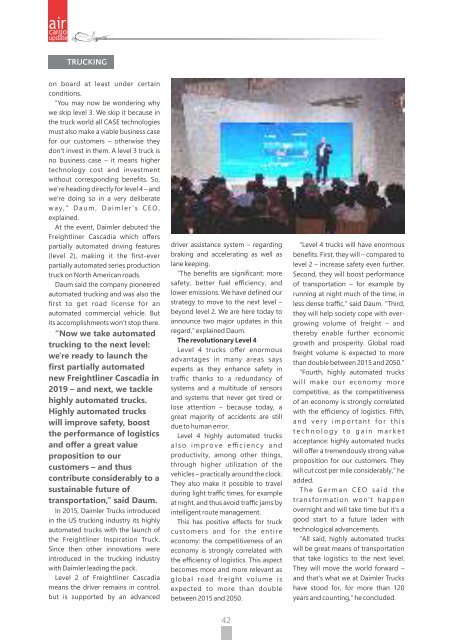ACU
Create successful ePaper yourself
Turn your PDF publications into a flip-book with our unique Google optimized e-Paper software.
TRUCKING<br />
on board at least under certain<br />
conditions.<br />
“You may now be wondering why<br />
we skip level 3. We skip it because in<br />
the truck world all CASE technologies<br />
must also make a viable business case<br />
for our customers – otherwise they<br />
don't invest in them. A level 3 truck is<br />
no business case – it means higher<br />
technology cost and investment<br />
without corresponding benefits. So,<br />
we're heading directly for level 4 – and<br />
we're doing so in a very deliberate<br />
w a y , ” D a u m , D a i m l e r ' s C E O ,<br />
explained.<br />
At the event, Daimler debuted the<br />
Freightliner Cascadia which offers<br />
partially automated driving features<br />
(level 2), making it the first-ever<br />
partially automated series production<br />
truck on North American roads.<br />
Daum said the company pioneered<br />
automated trucking and was also the<br />
first to get road license for an<br />
automated commercial vehicle. But<br />
its accomplishments won't stop there.<br />
“Now we take automated<br />
trucking to the next level:<br />
we're ready to launch the<br />
first partially automated<br />
new Freightliner Cascadia in<br />
2019 – and next, we tackle<br />
highly automated trucks.<br />
Highly automated trucks<br />
will improve safety, boost<br />
the performance of logistics<br />
and offer a great value<br />
proposition to our<br />
customers – and thus<br />
contribute considerably to a<br />
sustainable future of<br />
transportation,” said Daum.<br />
In 2015, Daimler Trucks introduced<br />
in the US trucking industry its highly<br />
automated trucks with the launch of<br />
the Freightliner Inspiration Truck.<br />
Since then other innovations were<br />
introduced in the trucking industry<br />
with Daimler leading the pack.<br />
Level 2 of Freightliner Cascadia<br />
means the driver remains in control,<br />
but is supported by an advanced<br />
driver assistance system – regarding<br />
braking and accelerating as well as<br />
lane keeping.<br />
“The benefits are significant: more<br />
safety, better fuel efficiency, and<br />
lower emissions. We have defined our<br />
strategy to move to the next level –<br />
beyond level 2. We are here today to<br />
announce two major updates in this<br />
regard,” explained Daum.<br />
The revolutionary Level 4<br />
Level 4 trucks offer enormous<br />
advantages in many areas says<br />
experts as they enhance safety in<br />
traffic thanks to a redundancy of<br />
systems and a multitude of sensors<br />
and systems that never get tired or<br />
lose attention – because today, a<br />
great majority of accidents are still<br />
due to human error.<br />
Level 4 highly automated trucks<br />
a l s o i m p r o v e e ffi c i e n c y a n d<br />
productivity, among other things,<br />
through higher utilization of the<br />
vehicles – practically around the clock.<br />
They also make it possible to travel<br />
during light traffic times, for example<br />
at night, and thus avoid traffic jams by<br />
intelligent route management.<br />
This has positive effects for truck<br />
customers and for the entire<br />
economy: the competitiveness of an<br />
economy is strongly correlated with<br />
the efficiency of logistics. This aspect<br />
becomes more and more relevant as<br />
global road freight volume is<br />
expected to more than double<br />
between 2015 and 2050.<br />
“Level 4 trucks will have enormous<br />
benefits. First, they will – compared to<br />
level 2 – increase safety even further.<br />
Second, they will boost performance<br />
of transportation – for example by<br />
running at night much of the time, in<br />
less dense traffic,” said Daum. “Third,<br />
they will help society cope with evergrowing<br />
volume of freight – and<br />
thereby enable further economic<br />
growth and prosperity. Global road<br />
freight volume is expected to more<br />
than double between 2015 and 2050.”<br />
“Fourth, highly automated trucks<br />
will make our economy more<br />
competitive, as the competitiveness<br />
of an economy is strongly correlated<br />
with the efficiency of logistics. Fifth,<br />
a n d v e r y i m p o r t a n t f o r t h i s<br />
t e c h n o l o g y t o g a i n m a r k e t<br />
acceptance: highly automated trucks<br />
will offer a tremendously strong value<br />
proposition for our customers. They<br />
will cut cost per mile considerably,” he<br />
added.<br />
T h e G e r m a n C E O s a i d t h e<br />
transformation won't happen<br />
overnight and will take time but it's a<br />
good start to a future laden with<br />
technological advancements.<br />
“All said, highly automated trucks<br />
will be great means of transportation<br />
that take logistics to the next level.<br />
They will move the world forward –<br />
and that's what we at Daimler Trucks<br />
have stood for, for more than 120<br />
years and counting,” he concluded.

















